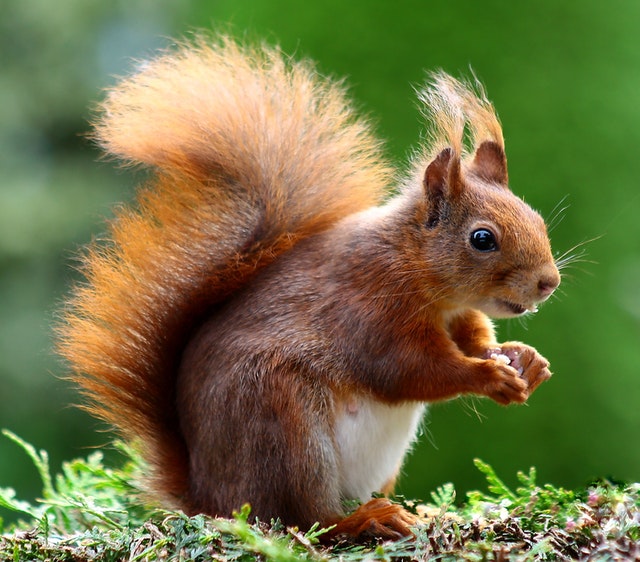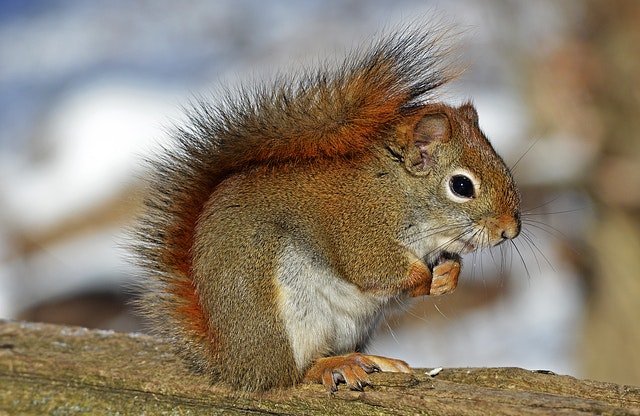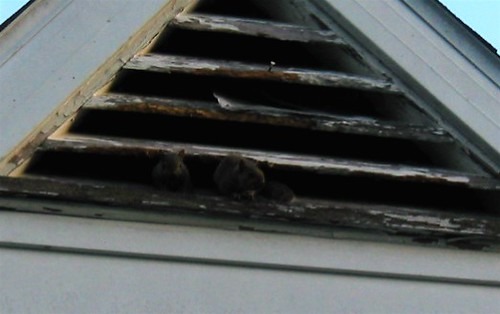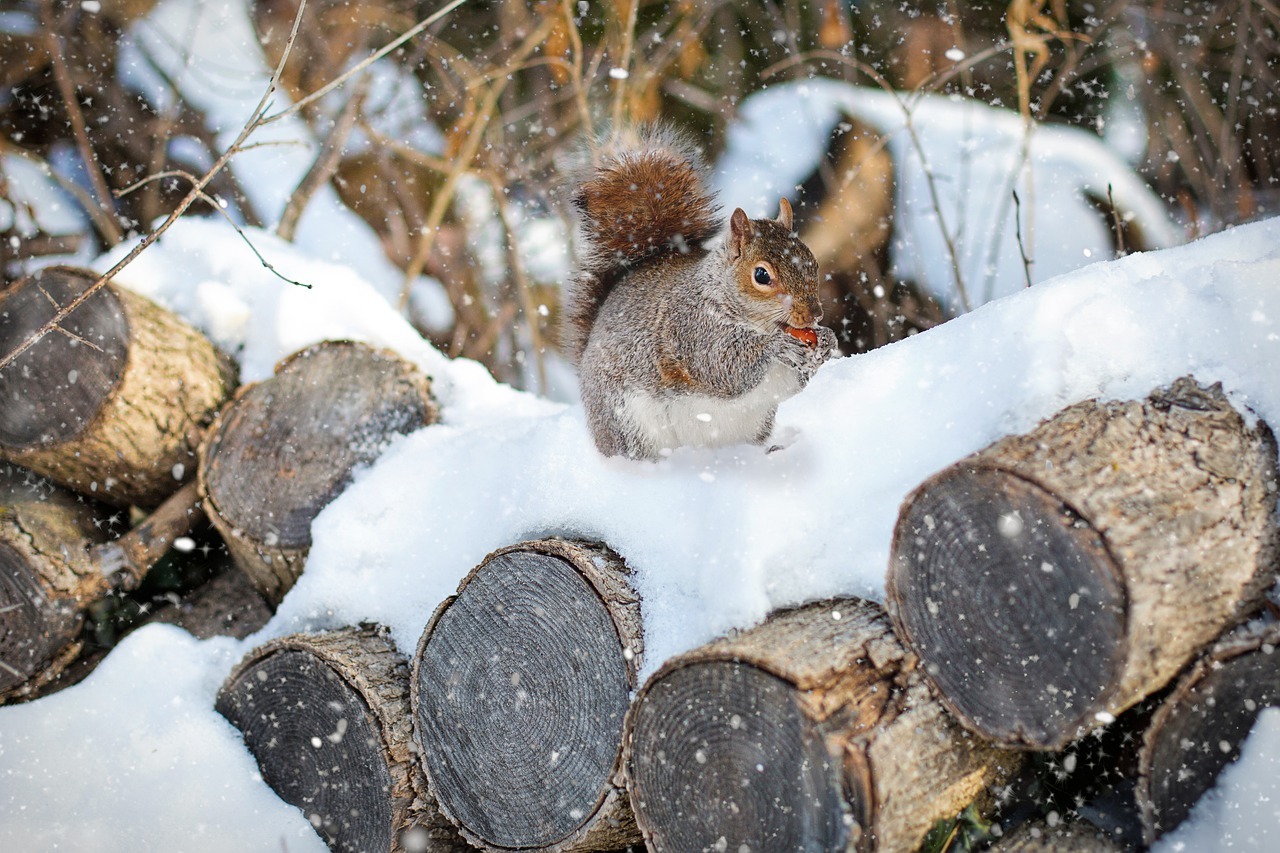by SOS Wildlife Control | Jan 13, 2016 | Squirrel Control
Last Updated: May 2016
One of the most common urbanized wildlife in Toronto and the GTA is squirrels. Quick footed and fast grabbers, squirrel problems have recently become an urban homeowner’s nightmare. Their small and flexible bodies allow them to go in and out of spaces, hide inside tree barks, and enter structures through cracks and small holes. They are superior climbers and can also utilize chimneys, shingles, and unscreened vents to enter buildings. Much like some of the other wildlife, fall is the season squirrels start looking for a winter home that provides them with safety and warmth. Squirrels are notorious for chewing on various materials like plastic pipes, vents, all kinds of woods, electrical wires, and even siding. Damage from their chewing can cause anything from costly repairs to floods and even fires. While severe damage and potential fires/floods are the more serious squirrel problems, there is also a lot of noise and disturbance caused by these little invaders.
How to identify squirrels on your property?
Usually home or business owners are alerted by the noise squirrels make. They are not nocturnal and can function on next to no sleep, which allow them to be on the go almost all the time. They make quick scampering, light thumping, and scratching sounds. They habituate mostly in the attics and between walls so that’s where the sounds usually come from. Aside from the sounds, they leave droppings, however this may be difficult to identify as homeowners don’t often inspect their attics regularly, or have access to survey between the walls. Though droppings and urine may not be visible, they do have an unpleasant and strong smell that can be an indicator of their presence.
Aside from causing damage to the inside and outside structure of a building; squirrel problems can also include inflicted damage to lawns. Squirrels dig holes to hide their food from their predators. They can chew up landscaped trees and bushes, plants, fruits and vegetables for consumption. What attracts them to residential yards are; bird-feeders, pet foods, and nut and fruit trees.
How to resolve squirrel problems?
While there are many options available for a homeowner to rid of squirrels on their own, there are lots of ambiguities one should be careful of. Results of online research suggest poison, deathly traps, etc. However these options are illegal in Canada and are considered as animal cruelty. There are criminal charges and penalties associated to such activities. One’s safest choice is to contact a professional wildlife removal company. At SOS Wildlife Control Incorporated, we can help identify their entry and exit points, and often times provide on-site removal services via live trapping methods. Live trapping is the most humane method to remove squirrels.
What are the Preventive Measures for Squirrel Problems?
There are measures homeowners can take to avoid squirrel problems. One of the most important things is to be aware of any holes or cracks on the foundation of their property. These cracks and holes need to be fixed, soffits need to be secured and sealed shut, and all doors and windows should shut properly. In addition, ensuring no pet food is left outside, bird-feeders and its surrounding are kept clean and free of spread food, and fruits from trees are picked regularly, and the fallen fruits are cleaned up before squirrels get to them, are helpful practices.
Although squirrel problems can be a major nuisance to property owners, their ability to cause damage doesn’t exactly define their characteristics. They are full of personality and fun facts. For an informative read and pictures, you can check out National Geographic‘s write-up on squirrels. For a more summarized fun read, here are some interesting facts about the feathery tailed members of the wildlife:
- Squirrels are natural gardeners. They have superior skills in digging holes for “planting” acorns. They do this gesture for the sole purpose of hiding their food. They bury thousands of acorns per season, and not all of them get found. This gives trees dispersal as it’s good for nuts to be buried in the soil for trees.
- As they are natural gardeners, they can distinguish their foods apart and can store them accordingly. Simple example is the difference between red oak and white oak acorns. White oak acorns germinate faster than the reds, so squirrels tend to eat the white oak acorns first and store the red oak ones for winter. A study in 1996 called Animal Behavior has revealed that squirrels bite off the embryo of white oak acorns, paralyzing the seed’s ability to sprout, which keeps longer without germinating. This gives them variety for winter time snacking.
- Squirrels are brilliant and they prepare for extreme weather conditions by collecting and storing food in hidden spots. In their natural habitats, they eat mushrooms. Many squirrels leave mushrooms between tree branches to dry as they keep better over winter.
- Squirrels can run 20 miles/hour, and their sweat glands are located on their feet.
- There are over 300 different types of squirrels but one of the most common ones we see are called “gray squirrels”. They are also referred to as “living fossils” because they haven’t changed in 37 million years.
Don’t let squirrel problems become an irritant in your life. It is very important to ensure you take action immediately after discovering squirrel invasion in your property. Their habit of chewing almost everything is an expensive repair work, but it can be even more destructive as electrical cables can cause fires, and chewed up water pipes could cause floods.
At SOS Wildlife Control Incorporated, we provide superior squirrel removal services for residential, commercial, and industrial clients. Let us help you solve your squirrel problems.
We can easily be reached at 1-800-981-0330. Don’t wait and call us to schedule an appointment for a thorough inspection to help evacuate all your unwanted wildlife guests in the most humane way possible.
by SOS Wildlife Control | Nov 6, 2015 | Squirrel Control, Uncategorized
Last Updated: May 2016
 Our Squirrel Removal technicians are ready to help in Toronto, Richmond Hill and the GTA. Removing squirrels can be costly if you don’t act fast. Coming into winter these critters will be looking for somewhere warm and dry to spend the cold winter months. The ideal space is your attic but keeping them out is the best option. Trim the trees from your house to reduce roof access. Remove rotten pumpkins that will attract them. Don’t overfill bird feeders and keep your pet bowls inside. Squirrels can cause a lot of damage if they enter your home. Some homeowners / business owners know they have squirrels and choose to do nothing about it, as they see no immediate problem. However it is. Squirrels teeth constantly grow and to keep them short and sharp squirrels gnaw on objects. This may be branches or nuts outside but in your home it will be your house structure, wires or whatever you have in the squirrels immediate space. Holes in the structure of your house will be costly to fix and increase your energy bill. Chewed wires are a fired hazard. It is common in Ontario for Squirrels to be blamed for power outages, one squirrel got electrocuted and knock out the whole power of Toronto’s Financial Sector for two hours. Generally animals play a large part in outages outside of the downtown area and cause house fires. Removing squirrels immediately will help avoid costly wildlife damage. The amount of damage depends on how long they remain in your attic.They will not cause a lot of damage if they have been in your attic for less than 2 weeks. If it has been a few months though the damage may be substantial. Attic Insulation can be compromised. Squirrels trample the insulation running back and forth, use it for nests and areas will be covered in urine and feces
Our Squirrel Removal technicians are ready to help in Toronto, Richmond Hill and the GTA. Removing squirrels can be costly if you don’t act fast. Coming into winter these critters will be looking for somewhere warm and dry to spend the cold winter months. The ideal space is your attic but keeping them out is the best option. Trim the trees from your house to reduce roof access. Remove rotten pumpkins that will attract them. Don’t overfill bird feeders and keep your pet bowls inside. Squirrels can cause a lot of damage if they enter your home. Some homeowners / business owners know they have squirrels and choose to do nothing about it, as they see no immediate problem. However it is. Squirrels teeth constantly grow and to keep them short and sharp squirrels gnaw on objects. This may be branches or nuts outside but in your home it will be your house structure, wires or whatever you have in the squirrels immediate space. Holes in the structure of your house will be costly to fix and increase your energy bill. Chewed wires are a fired hazard. It is common in Ontario for Squirrels to be blamed for power outages, one squirrel got electrocuted and knock out the whole power of Toronto’s Financial Sector for two hours. Generally animals play a large part in outages outside of the downtown area and cause house fires. Removing squirrels immediately will help avoid costly wildlife damage. The amount of damage depends on how long they remain in your attic.They will not cause a lot of damage if they have been in your attic for less than 2 weeks. If it has been a few months though the damage may be substantial. Attic Insulation can be compromised. Squirrels trample the insulation running back and forth, use it for nests and areas will be covered in urine and feces
Additional side effects to the physical damage is the noise they cause. We get many early phone calls from homeowners woken by the squirrels running back and forth the attic. They are quite noisy and irritating. If squirrels die in a unreachable area in your home the smell of their decay can be quite strong and can last for a few weeks. Removing squirrels immediately will help avoid this. With so many dangers in working at heights and possible parasites from the squirrel feces and getting bit or scratched by the squirrel itself, it’s best to call someone who knows the dangers of the job.
Baby Squirrel Removal
Please read further on our baby squirrel removal method. Squirrels have babies twice a year, spring and fall. With babies involved, it is a different removal procedure as mother and babies need to be reunited outside. Read our article Baby Squirrel Removal.
Amazing Squirrel Fact:
Although squirrels rarely interact, they learn who their nearby relatives are by hearing their unique calls. If they fail to hear a relative’s calls for a few days, they may investigate and rescue orphans.
Removing Squirrels
SOS Wildlife Control Incorporated removes squirrels with the use of one-way doors and occasionally live trapping to ensure squirrels do not get trapped inside, causing more unnecessary damage. Our experienced technicians will then seal all entry points with gauge screening, preventing the return of nuisance pests. If requested we will determine any other vulnerable areas of your home and secure these areas using rust proof screens to prevent them from getting back in. By Ontario law the squirrels are then released one kilometer away. A squirrel nest, called a “drey”, is usually built high up in the trees but if no tree is available, the squirrel will build it in the next best thing: your attic. SOS Wildlife Control Incorporated always release the animal in the best possible area for the squirrel to easily adapt to. Squirrels have oil in their fur that can leave a scent behind for years in your home, so even if that animal is removed, if another comes around it could smell the scent and make itself at home. Ensure all the weak areas of your home are reinforced and all holes are covered – wildlife proofing your property.
SOS Wildlife Control Incorporated has plenty experience removing squirrels in attics, squirrels in businesses, removing squirrels from walls, removing squirrels from soffits.
Removing Squirrels? Call SOS Wildlife Control Incorporated at 1.800.981.0330
by SOS Wildlife Control | Sep 23, 2015 | Squirrel Control
Last Updated: May 2016
Squirrel in the Attic?
An attic provides a safe shelter for a squirrel, and usually meets all of their living requirements: shelter, safety and food. The first step if you have a squirrel in the attic is to identify if there really is a squirrel in the attic as it may be a raccoon or another wildlife animal. Next, you’ll need to determine how to remove the squirrel in the attic. Last, you need to know how to prevent future squirrels in the attic.
How to know you have a Squirrel in the Attic
Three common ways to identify if you have a squirrel in the attic is by sight, noise, damage.
Sight
The easiest way to know you have a squirrel is to spot it. You may see it entering or leaving however this could be rare as they are very skilled at staying hidden. Squirrels are active early in the morning and make a lot of noise, this may be the best time to spot them. If you do see a squirrel in the attic have them removed immediately.
Noise
The most common way to know you have a squirrel in the attic is to hear it. Noise is the primary way our customers know they have a squirrel in the attic. We get calls early in the morning as the squirrel in the attic can be a definite nuisance. A squirrel in the attic can be very loud, move fast and keep you awake at night compared to a raccoon who moves slower and are heavier. Raccoons are nocturnal and only make noise mainly at night were a squirrel will make noises throughout the day.
Damage
You can also identify a squirrel problem by the damage they cause. They may destroy anything that gets in their way in their search for food. They will knock over garbage cans, break glass, and destroy property. The longer you have a squirrel in the attic the more damage they will cause. Having a squirrel for two weeks will cause a lot of damage to your attic as they can chew through the wood at the side of your house or chew through soffits to gain access. They don’t just make one entryway they make several and having several holes on your roof affects the energy costs in your house. In some cases, squirrels chew on electric wires which can cause a fire hazard. As soon as you notice a squirrel in the attic you should have them removed immediately! For more information on squirrel damages read our Squirrel Removal page.
What to do if you have a squirrel in the attic?
If you have a squirrel in the attic you have two options to remove it: Do it yourself squirrel removal or hire a professional like SOS Wildlife Control Incorporated to remove the squirrel in the attic for you.
Do it yourself squirrel removal
Gimmick Products:
This involves using sprays, loud music, sound devices and other gimmicks to scare away the squirrel. Although these methods may work temporarily, the squirrel usually returns.
Eliminate Attractants
Other ways you can resolve a squirrel problem without trapping the animal is to eliminate whatever is attracting the squirrel to your property – garbage, pet food, a pond, tree branches etc. Assess you house for weak points where they may enter and exit.
There is a lot of dangers with do it yourself squirrel removal and you may spend a lot of time and money on gimmicks that don’t work. We highly recommend removing squirrels professionally by someone who is a trained expert with experience. If you are going to try to remove the squirrel yourself please read up on the Ministry of Natural Resources Laws. It’s important to make sure the safety and welfare of the animal is considered at all times. Check out out Squirrel Removal page for more information.
Baby Squirrels in the Attic
 If you have a squirrel in the attic, be aware that depending on the time of the year, there is a high chance for baby squirrels to be present as well. If you have baby squirrels in the attic, do not remove them by yourself, hire a professional. Mother squirrels are extremely protective of there young. You will not want to enter an attic with a mother squirrel and babies as a wild animal in a confined space protecting her young can be dangerous! Read our method for baby squirrel removal on our Squirrel Removal page.
If you have a squirrel in the attic, be aware that depending on the time of the year, there is a high chance for baby squirrels to be present as well. If you have baby squirrels in the attic, do not remove them by yourself, hire a professional. Mother squirrels are extremely protective of there young. You will not want to enter an attic with a mother squirrel and babies as a wild animal in a confined space protecting her young can be dangerous! Read our method for baby squirrel removal on our Squirrel Removal page.
Prevent future Squirrel in the Attic
To prevent future animals entering your home SOS Wildlife Control Incorporated provides wildlife prevention for your home. Wildlife Prevention helps keep them out and is a very smart move to save you money in the future. Read our Wildlife Prevention page for more information.
Call SOS Wildlife if you have a squirrel in the attic
647-994-9453
by SOS Wildlife Control | Aug 3, 2015 | Squirrel Control
Last Updated: May 2016
 How to Remove Squirrels from your home
How to Remove Squirrels from your home
The presence of these mammals in the attic is a common problem. One of the common signs of infestation are the sounds of chirping, scratching and jumping around from above the ceiling. Once you have identified the squirrels, it’s time to have them be gone. There are multiple solutions to squirrel removal. The best solution for squirrel removal is to hire a professional. Experts like SOS Wildlife Control Incorporated are fully trained and have years of experience in squirrel removal. Throughout the years we have had many calls for squirrel removal and are very familiar with squirrel life cycle and habits. Most importantly, wildlife control technicians know the rules and regulations in wildlife removal.
If you hire SOS Wildlife Control Incorporated, we will arrive at your home, inspect the area and provide you with a thorough outline of what the problem is, the main entry points and the squirrel removal options you have. The next step (upon hire) is an attic inspection. This is a hands on approach and allows us to invade the animals space. We can identify if there are babies involved or if it’s only adults. The standard humane method for squirrel removal is with a one way door covering the main entry hole. All other entry holes are blocked. This ensures that the squirrel leaves through only the one-way door and cannot re-enter. This method ensures animals do not get locked inside a building and it greatly reduces the possibility of property damage. If we snare or trap the animal, the squirrel is then relocated one kilometer away in accordance with the law.
Depending on the time of year, there may be babies involved. If so, call a professional as the babies need to be removed and reunited with their mother who will relocate the babies herself. With babies involved, the technician seeks out the babies and removes them from the property. During the search of the attic the technician must be aware that the mother squirrel may be lurking in the dark. It is her instinctive nature to protect her young and may be provoked when they approached. Being attacked in a confined attic space is the last thing anyone wants! The mother squirrel needs to be chased out of the attic through an one way door or kept at bay in order to get to the babies. Once the technician have the babies, they will put them in an insulated heated box close to the one-way door installed. When the mother feels that it is safe she will come back and relocate the babies one by one to a pre-established den.
Do It Yourself Advice
If the animals pose no immediate threat to health and safety, then residents may choose to wait until the adults and any young have left the home or property, and then close the access point to prevent re-entry. Residents taking this approach must ensure that all young animals have left the nest or den, which normally means waiting until the young are weaned. It is not recommended to conduct do-it-yourself methods for wildlife removal, but if you must here are some tips that may help. Read up on your local wildlife legislation before attempting to do it yourself.
- If you think there is an animal under your porch or in your attic you should identify the entry point.
- Inspect the potential entry point after dark when the animal would have left to gather food
- Inspect for tracks or use a thin layer of sand/flour at the entrance if your ground isn’t suitable for tracks
- Identify the tracks by using a wildlife guide or Google image them
- Do not seal the only entry point and trap the animal. This is very inhumane, the animal may still be inside and die of starvation
- To humanely remove the animal yourself you can set up a bright light and leave it on through the day and night. You can also turn on a radio or other ongoing sound and leave it playing in the area. The animal will be discouraged from the light or noise and will eventually leave.
Never trap the animal yourself or set up your own traps.
Once you have rid the animal from your property deny them access to attractants, which can be food or shelter. Close up all entry points after you are 110% sure the animal has left. Keep all garbage and composts in secure containers or enclosures as those odors attract pests. For prevention tips against raccoon’s, squirrels, skunks etc. follow the guidelines and practical tips listed in our blog “Wildlife Proofing your Property“.



 Our Squirrel Removal technicians are ready to help in
Our Squirrel Removal technicians are ready to help in  If you have a squirrel in the attic, be aware that depending on the time of the year, there is a high chance for baby squirrels to be present as well. If you have baby squirrels in the attic, do not remove them by yourself, hire a professional. Mother squirrels are extremely protective of there young. You will not want to enter an attic with a mother squirrel and babies as a wild animal in a confined space protecting her young can be dangerous! Read our method for baby squirrel removal on our Squirrel Removal page.
If you have a squirrel in the attic, be aware that depending on the time of the year, there is a high chance for baby squirrels to be present as well. If you have baby squirrels in the attic, do not remove them by yourself, hire a professional. Mother squirrels are extremely protective of there young. You will not want to enter an attic with a mother squirrel and babies as a wild animal in a confined space protecting her young can be dangerous! Read our method for baby squirrel removal on our Squirrel Removal page.